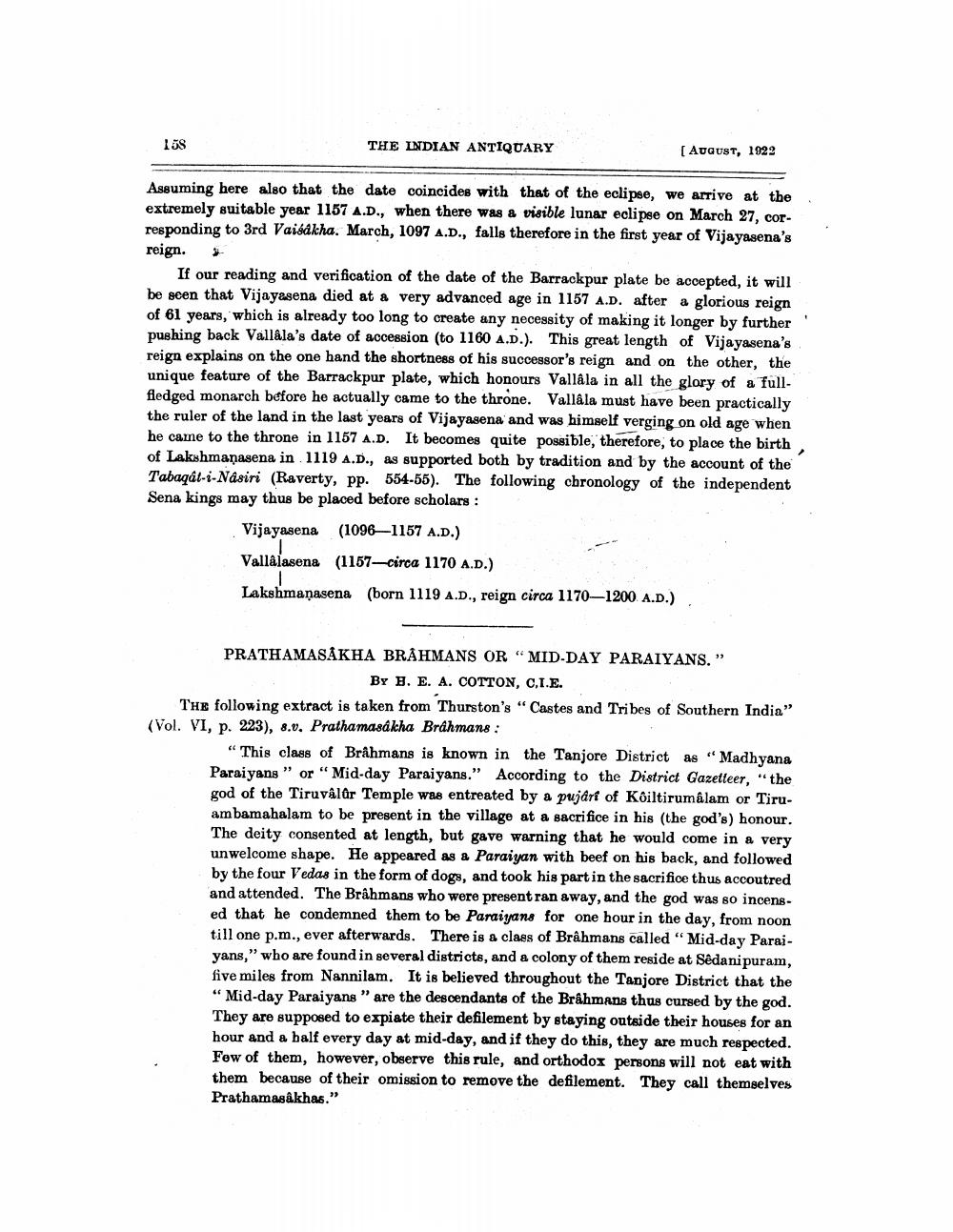________________
158
THE INDIAN ANTIQUARY
[ August, 1922
Assuming here also that the date coincides with that of the eclipse, we arrive at the extremely suitable year 1157 A.D., when there was & visible lunar eclipse on March 27, corresponding to 3rd Vaisakha. March, 1097 A.D., falls therefore in the first year of Vijayasena's reign. 5
If our reading and verification of the date of the Barrackpur plate be accepted, it will be seen that Vijayasena died at a very advanced age in 1157 A.D. after a glorious reign of 61 years, which is already too long to create any necessity of making it longer by further pushing back Vallala's date of accession (to 1160 A.D.). This great length of Vijayasena's reign explains on the one hand the shortness of his successor's reign and on the other, the unique feature of the Barrackpur plate, which honours Vallala in all the glory of a fullfledged monarch before he actually came to the throne. Vallala must have been practically the ruler of the land in the last years of Vijayasena and was himself verging on old age when he came to the throne in 1157 A.D. It becomes quite possible, therefore, to place the birth of Lakshmanasena in 1119 A.D., as supported both by tradition and by the account of the Tabaqâl-i-Nasiri (Raverty, pp. 554-55). The following chronology of the independent Sena kings may thus be placed before scholars :
Vijayasena (1096—1157 A.D.) Vallalasena (1157—circa 1170 A.D.) Lakshmanasena (born 1119 A.D., reign circa 1170-1200 A.D.)
PRATHAMASÅKHA BRAHMANS OR "MID-DAY PARAIYANS.”
BY J. E. A. COTTON, C.L.E. The following extract is taken from Thurston's "Castes and Tribes of Southern India” (Vol. VI, p. 223), 8.0. Prathamasákha Brâhmans :
“This class of Brahmans is known in the Tanjore District as "Madhyana Paraiyans" or "Mid-day Paraiyans.” According to the District Gazetteer, "the god of the Tiruvâlûr Temple was entreated by a pujarf of Koiltirumalam or Tiruambamahalam to be present in the village at a sacrifice in his (the god's) honour. The deity consented at length, but gave warning that he would come in a very unwelcome shape. He appeared as a Paraiyan with beef on his back, and followed by the four Vedas in the form of dogs, and took his part in the sacrifice thus accoutred and attended. The Brâhmans who were present ran away, and the god was so incensed that he condemned them to be Paraiyans for one hour in the day, from noon till one p.m., ever afterwards. There is a class of Brahmans called "Mid-day Paraiyans," who are found in several districts, and a colony of them reside at Sēdanipuram, five miles from Nannilam. It is believed throughout the Tanjore District that the “Mid-day Paraiyans " are the descendants of the Brahmans thus cursed by the god. They are supposed to expiate their defilement by staying outside their houses for an hour and a half every day at mid-day, and if they do this, they are much respected. Few of them, however, observe this rule, and orthodox persons will not eat with them because of their omission to remove the defilement. They call themselves Prathamasåkhas."




